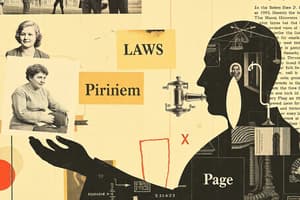Podcast
Questions and Answers
What is the primary purpose of copyright law?
What is the primary purpose of copyright law?
- To protect authored works (correct)
- To protect inventions
- To combat plagiarism
- To safeguard trade secrets
Which of the following laws is designed to protect inventions?
Which of the following laws is designed to protect inventions?
- Copyright law
- Plagiarism law
- Patent law (correct)
- Trade secret law
What is a significant issue associated with reverse engineering?
What is a significant issue associated with reverse engineering?
- It helps in safeguarding trade secrets
- It fosters innovation across industries
- It may lead to legal battles over intellectual property (correct)
- It ensures software is open source
What distinguishes competitive intelligence from industrial espionage?
What distinguishes competitive intelligence from industrial espionage?
What is cybersquatting?
What is cybersquatting?
What exclusive right is NOT granted to creators of original works?
What exclusive right is NOT granted to creators of original works?
Which type of work cannot be copyrighted?
Which type of work cannot be copyrighted?
What does the fair use doctrine allow?
What does the fair use doctrine allow?
Which of the following factors is NOT considered when evaluating fair use?
Which of the following factors is NOT considered when evaluating fair use?
What constitutes copyright infringement?
What constitutes copyright infringement?
What is a main focus of the World Intellectual Property Organization (WIPO)?
What is a main focus of the World Intellectual Property Organization (WIPO)?
What main issue arises with software copyright protection?
What main issue arises with software copyright protection?
Which statement about copyrights is true?
Which statement about copyrights is true?
What is the primary function of the Patent and Trademark Office (USPTO)?
What is the primary function of the Patent and Trademark Office (USPTO)?
Which of the following is NOT a requirement for an invention to be patentable?
Which of the following is NOT a requirement for an invention to be patentable?
What type of ideas are not patentable?
What type of ideas are not patentable?
What is considered patent infringement?
What is considered patent infringement?
What advantage does trade secret law have over patents?
What advantage does trade secret law have over patents?
What must a company do for information to qualify as a trade secret?
What must a company do for information to qualify as a trade secret?
Which of the following is a challenge faced by companies regarding trade secrets?
Which of the following is a challenge faced by companies regarding trade secrets?
What is the average cost of a patent lawsuit?
What is the average cost of a patent lawsuit?
What can a software patent protect?
What can a software patent protect?
What are noncompete agreements used for?
What are noncompete agreements used for?
What is plagiarism?
What is plagiarism?
Which of the following is a common misconception that students have about plagiarism?
Which of the following is a common misconception that students have about plagiarism?
What is reverse engineering primarily used for?
What is reverse engineering primarily used for?
What role does a decompiler play in the reverse engineering process?
What role does a decompiler play in the reverse engineering process?
Which statement about trademark infringement is true?
Which statement about trademark infringement is true?
What is the main purpose of competitive intelligence?
What is the main purpose of competitive intelligence?
Which of the following best describes cybersquatting?
Which of the following best describes cybersquatting?
What is one of the steps to combat student plagiarism?
What is one of the steps to combat student plagiarism?
Which of the following is NOT a characteristic of open source code?
Which of the following is NOT a characteristic of open source code?
What does the GNU General Public License (GPL) signify?
What does the GNU General Public License (GPL) signify?
An example of trademark is:
An example of trademark is:
What is a key consideration in the ethics of reverse engineering?
What is a key consideration in the ethics of reverse engineering?
What does the Anticybersquatting Consumer Protection Act allow trademark owners to do?
What does the Anticybersquatting Consumer Protection Act allow trademark owners to do?
Which of these practices involves ethical and legal information gathering?
Which of these practices involves ethical and legal information gathering?
Flashcards
Intellectual Property
Intellectual Property
Refers to creations of the mind, like inventions, literary and artistic works, symbols, names, images, and designs, owned by individuals or groups.
Copyright Law
Copyright Law
A legal right granted to the creator of original works of authorship, including literary, dramatic, musical, and certain other intellectual works.
Patent Law
Patent Law
A type of intellectual property that protects inventions, allowing inventors exclusive rights to make, use, and sell their invention for a set period of time.
Trade Secret Law
Trade Secret Law
Signup and view all the flashcards
Trade Secret
Trade Secret
Signup and view all the flashcards
Copyright
Copyright
Signup and view all the flashcards
Article I, Section 8, Clause 8
Article I, Section 8, Clause 8
Signup and view all the flashcards
Exclusive Right
Exclusive Right
Signup and view all the flashcards
Copyright Term
Copyright Term
Signup and view all the flashcards
Fair Use Doctrine
Fair Use Doctrine
Signup and view all the flashcards
Fair Use Factors
Fair Use Factors
Signup and view all the flashcards
Copyright Infringement
Copyright Infringement
Signup and view all the flashcards
Patent
Patent
Signup and view all the flashcards
Patent Infringement
Patent Infringement
Signup and view all the flashcards
Copyright Protection
Copyright Protection
Signup and view all the flashcards
Software Patent
Software Patent
Signup and view all the flashcards
Software Cross-Licensing Agreements
Software Cross-Licensing Agreements
Signup and view all the flashcards
Nondisclosure Clause
Nondisclosure Clause
Signup and view all the flashcards
Noncompete Agreements
Noncompete Agreements
Signup and view all the flashcards
Plagiarism
Plagiarism
Signup and view all the flashcards
Reverse Engineering
Reverse Engineering
Signup and view all the flashcards
Open Source Code
Open Source Code
Signup and view all the flashcards
Competitive Intelligence
Competitive Intelligence
Signup and view all the flashcards
Trademark Infringement
Trademark Infringement
Signup and view all the flashcards
Cybersquatting
Cybersquatting
Signup and view all the flashcards
Compiler
Compiler
Signup and view all the flashcards
Decompiler
Decompiler
Signup and view all the flashcards
Reverse Engineering Ethics
Reverse Engineering Ethics
Signup and view all the flashcards
Open Source Code Benefits
Open Source Code Benefits
Signup and view all the flashcards
Competitive Intelligence Advantages
Competitive Intelligence Advantages
Signup and view all the flashcards
Trademark Infringement Issues
Trademark Infringement Issues
Signup and view all the flashcards
Cybersquatting Ethics
Cybersquatting Ethics
Signup and view all the flashcards
ICANN and Cybersquatting
ICANN and Cybersquatting
Signup and view all the flashcards
Study Notes
Intellectual Property Overview
- Intellectual property (IP) refers to creations of the mind, such as inventions, literary and artistic works, designs, and symbols.
- Organizations are concerned with protecting IP as it represents a source of value (e.g., economic viability).
- IP protection methods include copyrights, patents, and trade secrets.
- Each method has inherent strengths and limitations.
Copyrights
- Copyrights are established by the U.S. Constitution (Article I, Section 8, Clause 8).
- They grant exclusive rights (e.g., distribute, display, perform, reproduce) to creators of original works.
- Copyright protection extends to various creative works (e.g., architecture, audiovisual works, choreography, drama, literature, music, motion pictures, pantomimes, pictures, sound recordings).
- There is a specific copyright term defined by law.
- Copyright infringement occurs when substantial parts of a copyrighted work are used without permission.
- The fair use doctrine allows for the use of copyrighted material without permission under specific circumstances (e.g., balance between author rights and public access), and various criteria are considered.
- Complicated issues of interpretation arise in relation to software copyrights.
- The World Intellectual Property Organization (WIPO) is an agency of the United Nations advocating for intellectual property (IP) owners and provides additional protections for electronic media.
Patents
- Patents are grants of property rights to inventors issued by the USPTO.
- They allow inventors to exclude others from using, making or selling their invention.
- Patents must meet specified criteria: be useful, novel, and non-obvious.
- Patents do not cover abstract ideas, laws of nature, or natural phenomena.
- Software-related patents raise complicated interpretation issues in copyright law.
- A significant amount of software-related patents have been issued.
Trade Secrets
- Trade secrets are confidential business information with economic value that require effort or cost to develop.
- The information must be unique or novel and generally unknown to the public.
- Trade secret protection is crucial for business success, as some critical information might not be otherwise protected (e.g., customer lists).
- Trade secret law includes legal advantages (e.g., no time limitations, no need to file, no application fees) over copyrights and patents.
- Confidentiality and protection practices by companies are key to enforcing trade secrets.
Employees and Trade Secrets
- Employees pose a significant threat to trade secret protection.
- Unauthorised use of company information (customer lists etc.) occurs.
- Educating workers and implementing non-disclosure clauses in contracts can help mitigate these risks.
- Non-compete agreements are employed to protect intellectual property from competitor use and have various enforcement standards across states.
Key Intellectual Property Issues
- Issues apply to intellectual property and information technology: plagiarism, reverse engineering, open source code, competitive intelligence, trademark infringement, and cybersquatting.
Plagiarism
- Plagiarism is the act of presenting someone else's work or ideas as one's own.
- Plagiarism can occur in various ways including copying work and passing it off as one's own, or failing to properly attribute sources.
- Students, and anyone, frequently plagiarize, either through misunderstanding or misunderstanding the relevance of proper attribution.
- Plagiarism detection systems are used in academia and beyond.
Reverse Engineering
- Reverse engineering is the process of taking something apart to understand, copy, or improve it.
- This process is applied to hardware and software.
Open Source Code
- Open source code is program source code available for modification by users or other developers.
- Its core premise is that many programmers collaborating can enhance software.
- The GNU General Public License (GPL) is an example.
Competitive Intelligence
- Competitive intelligence involves legally gathering information on rivals to gain a strategic advantage.
- This gathering differentiates itself from industrial espionage which involves the illegal gathering of information not available through other sources.
- This process is often integrated into a company's overall strategic plan and decision-making.
Trademark Infringement
- Trademarks (logos, designs, phrases etc.) differentiate one company's product from another.
- Trademark owners prevent others from using similar marks on products.
- Organizations often sue each other over trademark usage.
Cybersquatting
- Cybersquatters often register domain names containing famous trademarks to resell them at inflated prices.
- To combat this fraudulent conduct, entities often proactively register all possible applicable domain names.
- Agencies such as ICANN handle these matters.
Studying That Suits You
Use AI to generate personalized quizzes and flashcards to suit your learning preferences.




